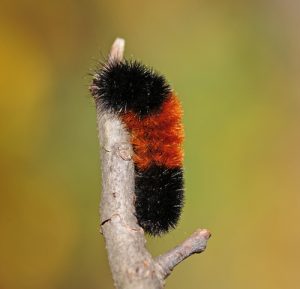Can Woolly Bear Caterpillars Predict the Winter?
By Chris Williams on November 15, 2011.
Q. Is it true that you can predict how bad the winter is going to be by the colors on the woolly bear caterpillars? I heard that the narrower the rust-colored band in the middle, the more severe the coming winter will be. In that case, this winter should be a doozy based on the woolly bears I’ve seen!
A. This is another example of fun with folklore! Predicting weather using woolly bear caterpillars is definitely not an exact science. It’s more of a fun thing, like using the behavior of the groundhog, “Punxsutawney Phil,” to predict an early spring. We love to think it might be true.
A woolly bear’s typical coloration is black with a brown or rust-colored band around the middle. The width of that rust section can vary greatly, and sometimes is not there at all. Or, the entire caterpillar can be rust-colored. The old wisdom is that a wide rust band means a mild winter and the narrower the band, the harsher the coming winter. It gets even more detailed. Supposedly the position of the widest dark section indicates which part of the winter will be the coldest. If the black band is wider at the head end, the beginning of the winter will be the most severe, while if the black band is wider at the tail end, the second half of the winter will be worse.
 Even the direction that the woolly bear travels plays into the folklore predictions. If woolly bears are crawling in a southerly direction, they are trying to escape cold winter conditions in the north. If, however, woolly bears are crawling north, then that indicates a mild northern winter! The fact is, woolly bears are crawling randomly. They’ve left the dying grasses and weeds that they feed on and are trying to find a dark, sheltered place to spend the winter. That’s why we see so many of them crossing roads and sidewalks in the fall. If they make it across the road, they usually end up hibernating under bark, a rock, or under a log.
Even the direction that the woolly bear travels plays into the folklore predictions. If woolly bears are crawling in a southerly direction, they are trying to escape cold winter conditions in the north. If, however, woolly bears are crawling north, then that indicates a mild northern winter! The fact is, woolly bears are crawling randomly. They’ve left the dying grasses and weeds that they feed on and are trying to find a dark, sheltered place to spend the winter. That’s why we see so many of them crossing roads and sidewalks in the fall. If they make it across the road, they usually end up hibernating under bark, a rock, or under a log.
Actually, the woolly bear’s bands do say something about the weather, only the folklore has it wrong. It’s about the summer that has already been, not the coming winter. The woolly bear’s banding is based on how long it has been feeding, its age, and the species. Woolly bears start out all black. Each woolly bear sheds its skin, or molts, six times before becoming an adult. With each molt, it becomes less black and the rust section grows wider. If the growing season (and the vegetation) was good, the caterpillar gets bigger and the rust band gets wider. Entomologists say that moisture levels affect the band width as well.
How many people even know what a woolly bear turns into? It’s the larval form of the Isabella Tiger Moth. After its sixth and final molt, the caterpillar forms a cocoon and pupates. About two weeks later, an adult moth emerges. The tiger moth is orange-yellow with a 1.5 to 2 inch wingspan. The wings have a few dark speckles. There are several other species of woolly bear tiger moths and the caterpillars of each one have slightly different color patterns. So sometimes the variations in the caterpillars’ banding may just be that we are looking at a different species.